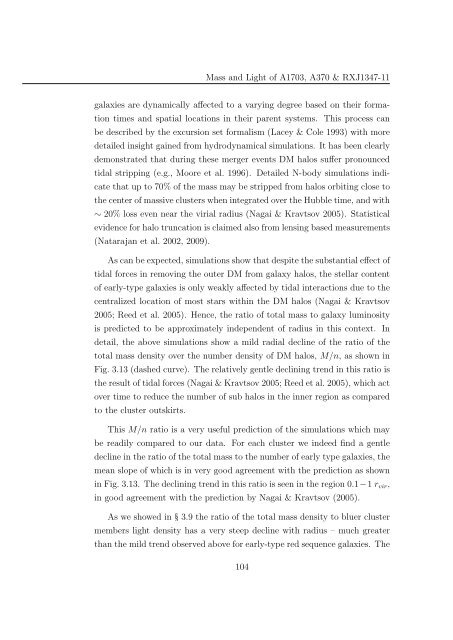Mass and Light distributions in Clusters of Galaxies - Henry A ...
Mass and Light distributions in Clusters of Galaxies - Henry A ...
Mass and Light distributions in Clusters of Galaxies - Henry A ...
You also want an ePaper? Increase the reach of your titles
YUMPU automatically turns print PDFs into web optimized ePapers that Google loves.
<strong>Mass</strong> <strong>and</strong> <strong>Light</strong> <strong>of</strong> A1703, A370 & RXJ1347-11<br />
galaxies are dynamically affected to a vary<strong>in</strong>g degree based on their formation<br />
times <strong>and</strong> spatial locations <strong>in</strong> their parent systems. This process can<br />
be described by the excursion set formalism (Lacey & Cole 1993) with more<br />
detailed <strong>in</strong>sight ga<strong>in</strong>ed from hydrodynamical simulations. It has been clearly<br />
demonstrated that dur<strong>in</strong>g these merger events DM halos suffer pronounced<br />
tidal stripp<strong>in</strong>g (e.g., Moore et al. 1996). Detailed N-body simulations <strong>in</strong>dicate<br />
that up to 70% <strong>of</strong> the mass may be stripped from halos orbit<strong>in</strong>g close to<br />
the center <strong>of</strong> massive clusters when <strong>in</strong>tegrated over the Hubble time, <strong>and</strong> with<br />
∼ 20% loss even near the virial radius (Nagai & Kravtsov 2005). Statistical<br />
evidence for halo truncation is claimed also from lens<strong>in</strong>g based measurements<br />
(Natarajan et al. 2002, 2009).<br />
As can be expected, simulations show that despite the substantial effect <strong>of</strong><br />
tidal forces <strong>in</strong> remov<strong>in</strong>g the outer DM from galaxy halos, the stellar content<br />
<strong>of</strong> early-type galaxies is only weakly affected by tidal <strong>in</strong>teractions due to the<br />
centralized location <strong>of</strong> most stars with<strong>in</strong> the DM halos (Nagai & Kravtsov<br />
2005; Reed et al. 2005). Hence, the ratio <strong>of</strong> total mass to galaxy lum<strong>in</strong>osity<br />
is predicted to be approximately <strong>in</strong>dependent <strong>of</strong> radius <strong>in</strong> this context. In<br />
detail, the above simulations show a mild radial decl<strong>in</strong>e <strong>of</strong> the ratio <strong>of</strong> the<br />
total mass density over the number density <strong>of</strong> DM halos, M/n, as shown <strong>in</strong><br />
Fig. 3.13 (dashed curve). The relatively gentle decl<strong>in</strong><strong>in</strong>g trend <strong>in</strong> this ratio is<br />
the result <strong>of</strong> tidal forces (Nagai & Kravtsov 2005; Reed et al. 2005), which act<br />
over time to reduce the number <strong>of</strong> sub halos <strong>in</strong> the <strong>in</strong>ner region as compared<br />
to the cluster outskirts.<br />
This M/n ratio is a very useful prediction <strong>of</strong> the simulations which may<br />
be readily compared to our data. For each cluster we <strong>in</strong>deed f<strong>in</strong>d a gentle<br />
decl<strong>in</strong>e <strong>in</strong> the ratio <strong>of</strong> the total mass to the number <strong>of</strong> early type galaxies, the<br />
mean slope <strong>of</strong> which is <strong>in</strong> very good agreement with the prediction as shown<br />
<strong>in</strong> Fig. 3.13. The decl<strong>in</strong><strong>in</strong>g trend <strong>in</strong> this ratio is seen <strong>in</strong> the region 0.1−1 r vir ,<br />
<strong>in</strong> good agreement with the prediction by Nagai & Kravtsov (2005).<br />
As we showed <strong>in</strong> § 3.9 the ratio <strong>of</strong> the total mass density to bluer cluster<br />
members light density has a very steep decl<strong>in</strong>e with radius – much greater<br />
than the mild trend observed above for early-type red sequence galaxies. The<br />
104
















